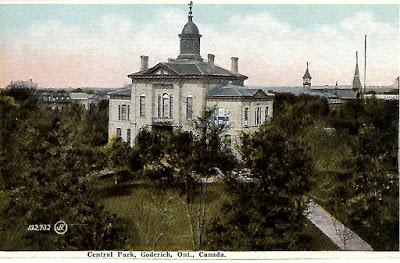
The Square (1920), archival image
The original courthouse, completed in 1856, burned down in 1954.
Huron County courthouse, before 1954 (postcard, Valentine and Sons United Publishing Co.)
The courthouse yard's shape was set by the town's co-founder, John Galt, impressed (as he was) by the insight of an ancient Roman planner, Marcus Vitruvius Pollio, whose idea it had been that polygonal sites are easier to protect from attackers, such as the Visigoths (or the Americans on the other side of Lake Huron).
The new courthouse, built in 1954 (Wikimedia Commons, JustSomePics [CC BY-SA 3.0 (https://creativecommons.org/licenses/by-sa/3.0)])
One was continually meeting history in Goderich -- in the old jail (already a museum when I lived there), in the lore about devastating storms that had swept in from the lake, in the local museum with its stuffed, two-headed calf and yard full of old artillery pieces, in the war memorial on the courthouse lawn.The most conspicuous history was a product of the early-to-mid-19th century, when the place was planned and built as an outpost of the British Empire. The Empire loomed at practically every turn. Among the town's streets are these: Victoria St., Trafalgar St., Nelson St., Wellington St., Waterloo St., Wolfe St., Brock St., Elgin Ave. The commemorations said little of the Indigenous peoples who had lived there for millennia: the Wendat (or Wyandotte), after whom the county was named, the Attiwandarons of the 'Neutral' Confederacy, and the Mississaugas. They were, for the most part, gone from the town and its official, public memory.
Goderich, like its environs in Huron and Bruce Counties (Alice-Munro country), was colonized mainly by Scots-Irish immigrants, some of whom had fled the Highland Clearances. Both of Goderich's co-founders, Galt and William 'Tiger' Dunlop, were Scotsmen. Dunlop took his nickname from an earlier imperial adventure (when he had tried to clear Saugor Island in India of its tigers). He and Galt worked for the Canada Company, the main function of which was to facilitate the movement of British and Irish settlers into the area.

Coat of Arms of the Canada Company
